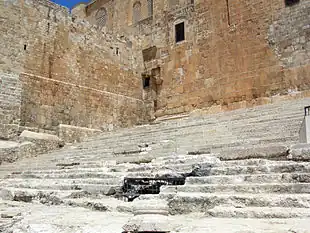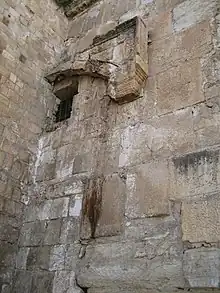31°46′32.74″N 35°14′9.98″E / 31.7757611°N 35.2361056°E

The Southern Wall (Hebrew: הכותל הדרומי HaKotel HaDromi) is the retaining wall of the Temple Mount at the southern end. It was built during King Herod's expansion of the Temple Mount platform southward on to the Ophel.
Construction
The Southern Wall is 922 feet (281 m) in length, and which the historian Josephus equates as being equal to the length of one furlong (Greek: stadion).[1] Herod's southern extension of the Temple Mount is clearly visible from the east, standing on the Mount of Olives or to a visitor standing on top of the Temple mount as a slight change in the plane of the eastern wall, the so-called "Straight Joint."[2] Herod's Royal Stoa stood atop this southern extension.[2] The retaining wall is built of enormous blocks of Jerusalem stone, the face of each ashlar (block) is edged with a margin, the bossage is raised about 3/8" above the surrounding margins. The unmortared blocks are so finely fitted together that a knife blade cannot be inserted between the ashlars.[2]
An enormous flight of steps leads to the Southern Wall from the south. They were excavated after 1967 by archaeologist Benjamin Mazar and are the northernmost extension of the pilgrims road leading from the Pool of Siloam to the Temple Mount via the Double Gate and the Triple Gate. These are the steps that Jesus of Nazareth[2][3] and other Jews of his era walked up to approach the Temple, especially on the great pilgrimage festivals of Passover, Shavuot and Sukkot.[2] The stairs that lead to the double gate are intact and "well-preserved."[4] The steps that lead to the triple gate were mostly destroyed.[4]
The risers are low, a mere 7 to 10 inches high, and each step is 12 to 35 inches deep, forcing the ascending pilgrims to walk with a stately, deliberate tread.[2] The pilgrims entered the temple precincts through the double and triple gates still visible in the Southern Wall.[5][2] Together, the double and triple gates are known as the Hulda Gates, after the prophetess Huldah.[2]

The present iteration of the Triple Gates is not Herodian. One of the three gates measures at its width 4.03 metres (13.2 ft). The only Herodian element visible from the outside is the doorjamb on the bottom of the left-hand arch.[2] The Double Gate is substantially concealed by a Crusader-era addition to the Temple Mount. Only half of the right-hand arch of the double gate is visible today from the outside, measuring at its exposed width 3.09 metres (10.1 ft).[2] Over the part of the right-hand Herodian arched doorway that is visible is an ornate, decorative half-arch dating to the Umayyad period (661–750 CE).[2] Just above it, the stub of an Herodian relieving arch is visible.[2]
Inside the Temple Mount, much of the original staircase and the arched, elaborately carved Herodian ceilings survive.[2] According to archeologist Meir Ben-Dov, "On his way in and out of the Temple, Jesus must have walked here."[3]
The internal parts of the Herodian Double Gate survive, although the waqf rarely permits visitors to see it.[2] Pilgrims, upon entering the Double Gate (70 metres (230 ft) westward of the Triple Gates), were not immediately greeted by a wide-open courtyard. Rather, they continued to ascend a flight of stairs in a dome-shaped passageway carved into the rock which led up to the royal cloisters described by Josephus (Antiquities 15.11.5. [15.410]),[6] cloisters which ran in a westerly-easterly direction along the full length of the Southern Wall, but which now lead up into the old section of the Al-Aqsa Mosque.[7] The domed ceilings of the great staircases are carved with elaborate floral and geometric designs.[2] Unlike the austere exterior gate, the interior of the gateway is elaborately decorated with ornately carved columns and ornamented domes. Two pairs of domes and their elaborate, surrounding columns survive intact.[2] Intricately carved vines, rosettes, flowers and geometric patterns cover "every inch" of the "impressive" entry to the ancient Temple.[2]
Archaeology

In a post-1967 dig led by archaeologists Benjamin Mazar and Meir Ben-Dov, it was discovered that the Hulda gates led into a grand staircase and served as the principal entrance to the temple in the Roman period.[8]
During the post-1967 digs, an elaborate group of Umayyad administration buildings and palaces were uncovered just outside the Southern Wall.[9] They have been carefully preserved and are now part of an archaeological park.[9] The Umayyad Caliphate is understood to have repaired damage to the Huldah Gates and Pilgrim stairs caused by the Roman destruction of Jerusalem in the year 70, in order to use them for access to the newly built Dome of the Rock.[9]
Latin inscription

Near the Double Gate is a reused marble slab with an inscription, that came from a statue of the emperor Antoninus Pius (138–161 AD). The Latin inscription (placed upside-down, and with the usual abbreviations) reads:
|
|
This is a piece of stone from the base of the statue of Antoninus Pius, which stood in the Temple of Jupiter, built by the Romans in Aelia Capitolina on the Temple Mount platform. The Bordeaux Pilgrim in 333 mentions two statues of the emperor Hadrian. Researchers believe that the second of these statues was dedicated to Hadrian's successor, Antoninus Pius, during whom the construction of Aelia Capitolina continued.[10]
Repair work

In the early 21st century, a new bulge was noticed in the Southern Wall, threatening the structural integrity of the masonry. Unauthorized underground construction of the el-Marwani Mosque was cited as the cause.[11] In a compromise between Israel, the Palestinian Authority and the Muslim Waqf that manages the property, it was decided that Jordan would manage the repairs.[11] The Jordanian repair, visible as a bright, white patch in the photo above, has been criticized as "unsightly", an "eyesore", and a "terrible job" because it is out of keeping with the common practices of historical restoration in being of a lighter color and smoother surface than the original stone.[11]
Points of interest
A number of points of interest are situated along the wall, within the al-Aqsa Compound and outside, including;[12]
Outside of the Wall
- the Ophel - the saddle between the Temple Mount and the City of David
- the Southern Steps: a large monumental flight of stairs on the southern side of the Temple Mount[13]
- Remains of Fatimid period fortifications
- Umayyad-period qasr-type residential and administrative structures
- the Huldah Gates (eastern and western)
Inside the Wall
From west to east:
- the al-Fakhariyya Minaret.
- the White Mosque (the Women's Mosque), today the al-Aqsa Library.
- the al-Aqsa Mosque (al-Qibli Mosque).
- the Musalla of Omar (Mosque of Omar): a musalla in the east wing of the al-Qibli Mosque.[14]
- the Miḥrāb Dāwūd: a miḥrāb in the wall.[15][16] (The name was also applied to the main tower of the city's citadel.)
Gallery
 Southwestern corner of the Southern wall showing pillars of Fatimid fortification
Southwestern corner of the Southern wall showing pillars of Fatimid fortification Close-up view of Southern Wall, near the western edge, showing the carved margins and raised bosses on the ashlars
Close-up view of Southern Wall, near the western edge, showing the carved margins and raised bosses on the ashlars Mikveh unearthed during excavations
Mikveh unearthed during excavations Pilgrim steps as they approach the Double Huldah Gate
Pilgrim steps as they approach the Double Huldah Gate Triple Huldah Gates
Triple Huldah Gates Visible portion of Double Gate
Visible portion of Double Gate Double Gate
Double Gate Triple Gate
Triple Gate Triple Gate in 1855 photo
Triple Gate in 1855 photo-Aerial-Temple_Mount-Al-Aqsa_Mosque_(east_exposure).jpg.webp) Aerial photo of Southern Wall (2013)
Aerial photo of Southern Wall (2013)
See also
- Archaeology of Israel
- Robinson's Arch
- Acra (fortress)
- Monastery of the Virgins, Byzantine, in the Ophel area
- Walls of Jerusalem
- Western Wall
References
- ↑ Josephus, Antiquities (15.11.3; XV.415–416), who described the dimensions of the Temple Mount in the following terms (apparently not including the extension made to the Temple Mount): “This hill was walled all round, and in compass four furlongs; [the distance of] each angle containing in length a furlong (Gr. stadion).” Compare Mishnah Middot 2:1 which states that the Temple Mount measured five-hundred cubits (Heb. amah) by five-hundred cubits. If it can be ascertained that Josephus' stadion is equivalent to the 500 cubits mentioned in the Mishnah, and being that the Southern Wall measured 281 meters, this would place each cubit (Heb. amah) at 56.205 cm. Rabbi Saadia Gaon, on the other hand, holds that a stadion was equivalent to only 470 cubits (v. Uziel Fuchs, "Millot HaMishnah" by R. Saadia Gaon — the First Commentary to the Mishnah, Sidra: A Journal for the Study of Rabbinic Literature, pub. Bar-Ilan University Press (2014), p. 66), in which case , each cubit was 59.792 cm, close to the 60 cm. cubit espoused by the Chazon-Ish.
- 1 2 3 4 5 6 7 8 9 10 11 12 13 14 15 16 17 Shanks, Hershel (1995). Jerusalem, an Archaeological Biography. Random House. pp. 141–151. ISBN 978-0-679-44526-5.
- 1 2 Moshe, Janet Mendelsohn (June 1, 2001). "Walking through Jerusalem 2,000 Years Ago". Israeli Ministry of Foreign Affair, Israel Magazine-On-Web.
- 1 2 Mazar, Eilat (2002). The Complete Guide to the Temple Mount Excavations. Jerusalem: Shoham Academic Research and Publication. pp. 55–57. ISBN 978-965-90299-1-4.
- ↑ Har-El, Menashe (2004). Golden Jerusalem. Gefen Publishing House. pp. 228–242. ISBN 978-965-229-254-4.
- ↑ Josephus, Antiquities 15.410
- ↑ Meir Ben-Dov (1980). Rubenstein, Chaim (ed.). Israel Guide - Jerusalem (in Hebrew). Vol. 10. Jerusalem: Keter Publishing House, in affiliation with the Israel Ministry of Defence. pp. 54, 67–68. OCLC 745203905.
- ↑ Rubinstein, Danny (September 12, 2004). "Remnants of the Temple?, Not in this Garbage". Haaretz.
- 1 2 3 "Umayyad Administration Center and Palaces". Ministry of Foreign Affairs, Archaeological Sites in Israel. July 29, 1998.
- ↑ Mare, W. Harold (1987). The Archaeology of the Jerusalem Area. Wipf and Stock Publishers. pp. 207–208. ISBN 1-57910-970-5.; Dan Bahat (1990). The Illustrated Atlas of Jerusalem. Simon & Schuster. p. 67. ISBN 978-0134516424.
- 1 2 3 Shanks, Hershel (2010). "First Person: Temple Mount Repairs Leave Eyesores". Biblical Archaeology Review. 36 (5).
- ↑ "Southern Wall of Temple Mount". Madain Project. Retrieved 15 June 2019.
- ↑ "Southern Steps". Madain Project. Archived from the original on 25 April 2020. Retrieved 25 April 2020.
- ↑ "Omer Mosque". Madain Project.
- ↑ "Mihrab Dawud". Madain Project.
- ↑ Elad, Amikam (1995). Medieval Jerusalem and Islamic Worship: Holy Places, Ceremonies, Pilgrimage. Brill. p. 137. ISBN 978-90-04-10010-7.
al-Suyūṭī […] regarding the location of Miḥrāb Dāwūd in his time [1470s]. 1. The Great Miḥrāb in the wall adjacent to the minbar inside al-ʾAqṣā Mosque; 2. The Great Miḥrāb in the southern wall of the Ḥaram; 3. In the citadel (al-Qalʾa) of Jerusalem. […] Mujīr states that the Miḥrāb in the southern wall of the Ḥaram, near the "Cradle of Jesus", is widely accepted as Miḥrāb Dāwūd.
[emphasis added]
